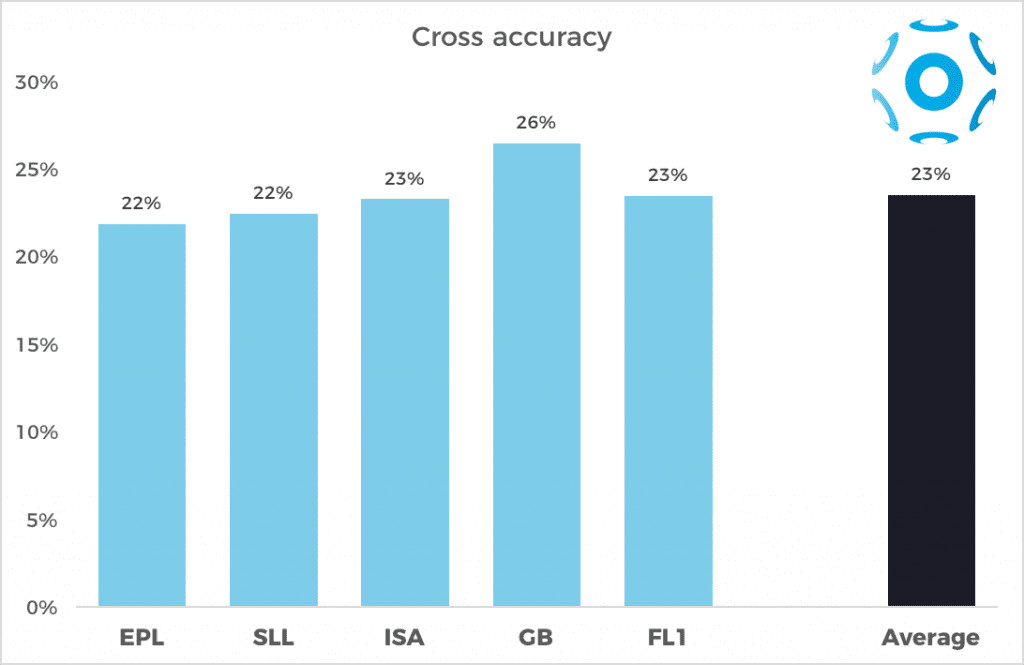Meta Description: Wondering what crossing means in soccer? This detailed guide explores the definition, effectiveness, and team strategies related to crossing in football, with insights and data relevant to U.S. fans. Discover more at CAUHOI2025.UK.COM and enhance your understanding of the beautiful game. Key terms: soccer tactics, crossing accuracy, attacking strategy.
1. Understanding Crossing in Football: A Tactical Overview
In football, crossing refers to an attempt to pass the ball from a wide position on the field towards the central attacking area, typically near the opponent’s goal. It’s a common tactic used to deliver the ball into the box, hoping a teammate can score with a header or volley. According to soccerment.com, top European teams average 18.6 crosses per match, showing its continued relevance.
1.1. Defining a Cross
A cross is specifically a pass made from the flanks, aimed to find a teammate in a more central position, usually inside the penalty box. This maneuver is designed to bypass defenders and create scoring opportunities.
1.2. The Purpose of Crossing
The primary goal of a cross is to create a scoring chance. By delivering the ball into the box, teams aim to exploit aerial ability, create chaos in the defense, and ultimately, score a goal.
2. The Effectiveness of Crossing: Is It a Worthwhile Strategy?
While crossing remains a popular tactic, its effectiveness is often debated. Statistics suggest that only a small percentage of crosses result in goals. However, its value can vary depending on the team’s composition and tactical approach.
2.1. Statistical Analysis of Crossing
According to the data presented by soccerment.com, on average, only about 1 out of every 64 crosses directly results in a goal. This raises questions about its efficiency as a primary attacking strategy.
2.2. Factors Influencing Crossing Effectiveness
Several factors influence the success rate of crosses:
- Accuracy of the Cross: The precision of the delivery is crucial. A poorly aimed cross is easily intercepted or goes out of play.
- Aerial Ability of Players: Teams with strong aerial players are more likely to convert crosses into goals.
- Defensive Organization: A well-organized defense can neutralize the threat of crosses.
3. Crossing Accuracy: A League-Based Comparison
Crossing accuracy varies across different leagues. Understanding these differences can provide insights into the tactical styles and player abilities in each league.
3.1. Average Cross Accuracy in Major European Leagues
Across the top five European leagues, the average cross accuracy is around 23.5%. This means that more than three out of four crosses do not reach a teammate.
 Cross accuracy in the 5 major European leagues
Cross accuracy in the 5 major European leagues
Chart 2: Cross accuracy by league
3.2. Bundesliga’s Higher Cross Accuracy
The German Bundesliga stands out with a slightly higher cross accuracy rate of 26.5%. This could be attributed to the emphasis on technical skills and coordinated play in the league.
4. Teams That Rely Least on Crossing
Some teams deliberately avoid relying heavily on crossing, preferring other attacking strategies. These teams often focus on possession-based football and intricate passing patterns.
4.1. Examples of Teams with Low Crossing Frequency
Teams like Barcelona, Napoli, and Manchester City are known for their low crossing frequency. They prioritize short passes and build-up play through the middle.
- Barcelona (SLL): 11.0 crosses per match, 1.7% of total passes
- Napoli (ISA): 16.2 crosses per match, 2.2% of total passes
- Arsenal (EPL): 14.3 crosses per match, 2.4% of total passes
- Las Palmas (SLL): 13.1 crosses per match, 2.5% of total passes
- Manchester City (EPL): 19.6 crosses per match, 2.7% of total passes.
4.2. Tactical Reasons for Avoiding Crosses
These teams often have players who excel in close control, passing, and movement, making ground-based attacks more effective. They aim to dissect defenses with precise passing rather than relying on aerial balls.
5. Teams That Rely Most on Crossing
On the other end of the spectrum, some teams heavily rely on crossing as a primary attacking strategy. These teams often have tall, physical forwards who excel in aerial duels.
5.1. Examples of Teams with High Crossing Frequency
Teams like Caen, Augsburg, and West Bromwich Albion are known for their high crossing frequency. They aim to exploit their forwards’ height and heading ability.
- Caen (FL1): 25.6 crosses per match, 7.1% of total passes
- Augsburg (GB): 22.9 crosses per match, 6.8% of total passes
- Eibar (SLL): 25.0 crosses per match, 6.1% of total passes
- Athletic Bilbao (SLL): 24.0 crosses per match, 5.8% of total passes
- West Bromwich Albion (EPL): 18.5 crosses per match, 5.8% of total passes.
5.2. Tactical Reasons for Relying on Crosses
These teams often employ wingers who can deliver accurate crosses, and their forwards are adept at winning aerial battles in the box. This combination makes crossing a viable attacking option.
6. Inter Milan: Europe’s Most Effective Crossing Team
Inter Milan stands out as one of the most effective crossing teams in Europe. Their tactical setup and player characteristics make them particularly dangerous from wide positions.
6.1. Tactical Structure and Player Characteristics
Under coach Luciano Spalletti, Inter Milan utilized a 4-2-3-1 formation that emphasized crossing. Players like Ivan Perisic and Antonio Candreva consistently delivered balls into the box for Mauro Icardi to attack.
 Inter Milan
Inter Milan
Inter Milan vs Cagliari (25 Nov ’17)
6.2. Key Players in Inter Milan’s Crossing Strategy
- Antonio Candreva: Known for his crossing ability, Candreva accounted for a significant percentage of Inter’s total crosses.
- Ivan Perisic: Perisic’s accurate crosses often led to key passes and scoring opportunities.
- Mauro Icardi: Icardi’s aerial ability and finishing skills made him a prime target for crosses.
7. The Role of Height and Physicality in Crossing
The height and physical presence of players significantly impact the effectiveness of crossing. Teams with tall forwards often prioritize crossing as a means of exploiting their aerial advantage.
7.1. How Height Influences Crossing Success
Tall forwards are more likely to win aerial duels and convert crosses into goals. Their height advantage allows them to outjump defenders and head the ball into the net.
7.2. Examples of Teams with Tall Forwards
Teams like Caen, with forwards Ronny Rodelin and Ivan Santini, exemplify this strategy. Their height makes them a constant threat from crosses.
8. The Impact of Tactical Formations on Crossing
Tactical formations play a crucial role in determining a team’s crossing strategy. Some formations are better suited for crossing than others.
8.1. Formations That Favor Crossing
Formations like 4-4-2 and 3-5-2 often emphasize crossing, as they provide width and opportunities for wingers to deliver balls into the box.
8.2. Formations That Discourage Crossing
Formations like 4-3-3 and 4-5-1 may discourage crossing, as they prioritize possession and build-up play through the middle.
9. Crossing vs. Other Attacking Strategies
Crossing is just one of many attacking strategies in football. Its effectiveness must be weighed against other options, such as through balls, dribbling, and set pieces.
9.1. Advantages of Crossing
- Exploiting Aerial Ability: Crossing allows teams to take advantage of their forwards’ aerial skills.
- Creating Chaos: A well-delivered cross can create confusion and disarray in the defense.
- Direct Route to Goal: Crossing can provide a direct route to goal, bypassing midfield congestion.
9.2. Disadvantages of Crossing
- Low Success Rate: The statistical probability of scoring from a cross is relatively low.
- Dependence on Accuracy: Crossing relies heavily on the accuracy of the delivery.
- Vulnerability to Interception: Crosses are susceptible to interception by defenders.
10. How to Improve Crossing Effectiveness
Teams can take steps to improve their crossing effectiveness, such as focusing on player training, tactical adjustments, and set-piece routines.
10.1. Training and Player Development
Players can improve their crossing accuracy through dedicated training drills and exercises. Developing aerial ability and coordination between crossers and receivers is also crucial.
10.2. Tactical Adjustments
Teams can adjust their tactics to create more crossing opportunities, such as positioning players in wide areas and overloading the box.
11. The Future of Crossing in Football
While crossing remains a prevalent tactic, its role in football may evolve as the game continues to develop. The rise of data analytics and tactical innovation could lead to new approaches to crossing and attacking play.
11.1. The Influence of Data Analytics
Data analytics can provide valuable insights into crossing effectiveness, helping teams to optimize their strategies and player selection.
11.2. Tactical Innovations
New tactical innovations could lead to more efficient and effective ways of utilizing crosses, such as combining them with other attacking strategies.
12. FAQ: Frequently Asked Questions About Crossing in Football
Here are some frequently asked questions about crossing in football, providing quick and concise answers.
Q1: What is a cross in soccer?
A1: A cross is a pass from a wide position, typically near the sidelines, aimed towards the center of the field, usually into the penalty box, to create a scoring opportunity.
Q2: How accurate are crosses in professional soccer?
A2: On average, only about 23.5% of crosses in the top five European leagues are accurate, meaning they reach a teammate.
Q3: Which teams rely most on crossing?
A3: Teams like Caen, Augsburg, and West Bromwich Albion are known for their high crossing frequency.
Q4: Which teams rely least on crossing?
A4: Teams like Barcelona, Napoli, and Manchester City are known for their low crossing frequency, preferring ground-based attacks.
Q5: Why do some teams rely on crossing?
A5: Teams rely on crossing to exploit the aerial ability of their forwards and create chaos in the opponent’s defense.
Q6: Is crossing an effective attacking strategy?
A6: While crossing can be effective, statistics suggest that only a small percentage of crosses directly result in goals.
Q7: How can teams improve their crossing effectiveness?
A7: Teams can improve their crossing effectiveness through dedicated training, tactical adjustments, and set-piece routines.
Q8: What is the role of height in crossing?
A8: The height and physical presence of players significantly impact the effectiveness of crossing, as tall forwards are more likely to win aerial duels.
Q9: What tactical formations favor crossing?
A9: Formations like 4-4-2 and 3-5-2 often emphasize crossing, as they provide width and opportunities for wingers to deliver balls into the box.
Q10: How does crossing compare to other attacking strategies?
A10: Crossing is just one of many attacking strategies in football, and its effectiveness must be weighed against other options, such as through balls and dribbling.
13. Need More Soccer Insights?
Still have questions about soccer tactics or want to delve deeper into the beautiful game? CAUHOI2025.UK.COM is your go-to resource for clear, reliable, and up-to-date information. We understand the challenges of finding trustworthy answers online, which is why we’re committed to providing well-researched and easily understandable content for U.S. fans.
13.1. Contact Us
For any comments, suggestions, or queries, don’t hesitate to reach out to us. Visit our “Contact” page on CAUHOI2025.UK.COM or write to us at Equitable Life Building, 120 Broadway, New York, NY 10004, USA, or call us at +1 (800) 555-0199.
13.2. Explore CAUHOI2025.UK.COM Today
Visit CauHoi2025.UK.COM today to explore more soccer strategies, tactics, and analysis. Discover the answers you need and elevate your understanding of the game.

